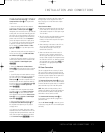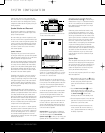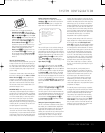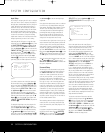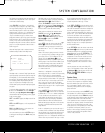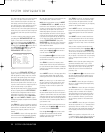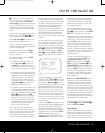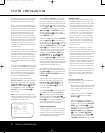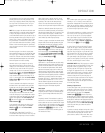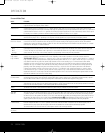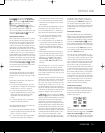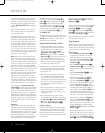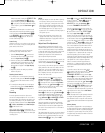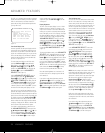
SYSTEM CONFIGURATIONSYSTEM CONFIGURATION
SYSTEM CONFIGURATION
21
SYSTEM CONFIGURATION
21
Button p to bring the CHANNEL
ADJUST
menu (Figure 8) to the screen.
Figure 8
4.When the CHANNEL ADJUST menu
appears, press the
¤
Button n until the on-
screen
›
cursor is next to the TEST TONE
line. Press the
‹
/
›
Buttons o so that ON is
shown and the AVR’s internal test tone will begin
to circulate from speaker to speaker in a clock-
wise direction into all speakers.The test noise will
play for two seconds in each speaker before cir-
culating, and a blinking on-screen cursor will
appear next to the name of each speaker location
when the sound is at that speaker.
5. Verify that the speakers have been properly con-
nected.As the test noise circulates, listen to make
certain that the sound comes from the speaker
position shown next to the
›
cursor in the on-
screen display and by the flashing indication in
the
Speaker/Channel Input Indicators ˆ.
If the sound from a speaker location does NOT
match the position indicated in the display, turn
the AVR 135 off using the
Main Power Switch
1 and check the speaker wiring or connections
to exter
nal power amplifiers to make certain that
each speaker is connected to the correct output
terminal.
Note: Remember that when your system has only a
single Surround Back speaker and is thus configured
for 6.1-channel operation,
you will hear the test tone
twice from the back speaker, once with the SBL indi-
cation and once with the SBR indication.This is nor-
mal,
and it allows you to adjust the output balance for
the mixing circuit that creates a 6.1 output when 7.1
modes such as Logic 7/7.1 are used.
6.After checking for speaker placement, let the test
noise circulate again, and listen to see which
channels sound louder than the others
.
Using the
front left speaker as a reference, press the
‹
/
›
Buttons o on the remote to bring all speakers
to the same volume level.When one of the
‹
/
›
Buttons o is pushed,
the test noise circulation
will pause on the channel being adjusted to give
you time to make the adjustment.
When you
release the button, the circulation will resume
after five seconds.
Continue to adjust the individual channels until the
volume level sounds the same from each speaker
.
Adjustments should be made with the
‹
/
›
Buttons
o on the remote only, NOT the main volume con-
trols. If you are using a sound-pressure level (SPL)
meter for precise level adjustment, set the volume
so that the meter reads 75dB on the C-W
eighting,
Slow scale.
If you find that the output levels are either uncomfort
-
ably low or high, you may repeat the procedure.
Return to Step 2 and adjust the master volume either
slightly higher or lower to accommodate your particu-
lar room layout and your tastes.You may repeat this
procedure as many times as necessary to achieve a
desired result. In order to prevent possible damage to
your hearing or your equipment, we emphasize that
you should avoid setting the master volume above
0dB.
When all channels have an equal volume level, the
adjustment is complete. Use the
⁄
/
¤
Navigation
Buttons
n to move the
›
cursor next to the
TEST TONE line, and press the
‹
/
›
Navigation Buttons o until the word OFF
appears to stop the test tone. Copy down the final
level settings for each channel so that you can easily
set them for the other source inputs.To exit this menu,
press the
⁄
/
¤
Navigation Buttons n until the
on-screen
›
cursor is next to the BACK TO
MASTER MENU line, and then press the Set
Button
p to return to the MASTER MENU.
NOTE: The subwoofer level is not adjustable when the
normal test tone is in use.The subwoofer output level
may also be adjusted when the channel levels are
being trimmed to an exter
nal program source rather
than the test tone, as shown on page 27.
Using the Semi-OSD
System
The output levels may also be adjusted at any time
using the remote control and semi-OSD system.To
adjust the output levels in this fashion, press the
Test
Button
i.
As soon as the button is pressed,
the
test tone will begin to circulate as indicated earlier. The
correct channel from which the test noise should be
heard will be shown in the lower third of the video
screen and in the
Lower Display Line ¯. While the
test noise is circulating
,
the proper channel position will
also be indicated in the
Speaker/Channel Input
Indicators
ˆ by a blinking letter within the correct
channel.
To adjust the output level, press the
⁄
/
¤
Buttons
n until the desired level is shown in the display or
on-screen. Once the buttons are released, the test
noise will begin to circulate again in five seconds.
When all channels have the same output level, press
the
Test Button i again to complete the process.
If you find that the output levels are either uncomfort-
ably low or high, you may repeat the procedure, but
first adjust the master volume either slightly higher or
lower (but not higher than 0dB) to compensate. Do
not adjust the volume during the procedure, as that will
cause the output levels to be higher or lower for only
some channels, resulting in uneven balance.
NOTE: Output level adjustment is not available for the
VMAx or Surround Off
modes.
Additional Input Adjustments
After one input has been adjusted for Surround mode
,
digital input (if any), speaker type, and output levels,
go back to the
INPUT SETUP line on the
MASTER MENU (Figure 1) and enter the set-
tings for each input that you will use. In most cases,
only the digital input and surround mode will be differ-
ent from one input to the next, while the speaker type,
crossover frequency, Night mode and output level
settings will usually be the same and may be quickly
entered by entering the same data used for the
original input.
When all settings and adjustments have been made,
press the
OSD Button v to return to normal oper-
ation of the AVR.
Once the settings outlined on the previous pages have
been made, the AVR 135 is ready for operation. While
there are some additional settings to be made, these
are best done after you have had an opportunity to lis-
ten to a variety of sources and different kinds of pro-
gram material.These advanced settings are described
on pages 28 and 29 of this manual.
In addition,
any
of the settings made in the initial configuration of the
unit may be changed at any time.As you add new or
different sources or speakers, or if you wish to change
a setting to better reflect your listening taste, simply
follow the instructions for changing the settings for that
parameter as shown in this section.
Having completed the setup and configuration process
for your AVR 135, you are about to experience the
finest in music and home theater listening
. Enjoy!
* CHANNEL ADJUST *
FL :0 dB SBR:0 dB
CEN:0 dB SBL:0 dB
FR :0 dB SL:0 dB
SR :0 dB SUB:0 dB
CHANNEL RESET :OFF
TEST TONE :OFF
BACK TO MASTER MENU
AVR 135 OM 12/3/04 12:11 PM Page 21



